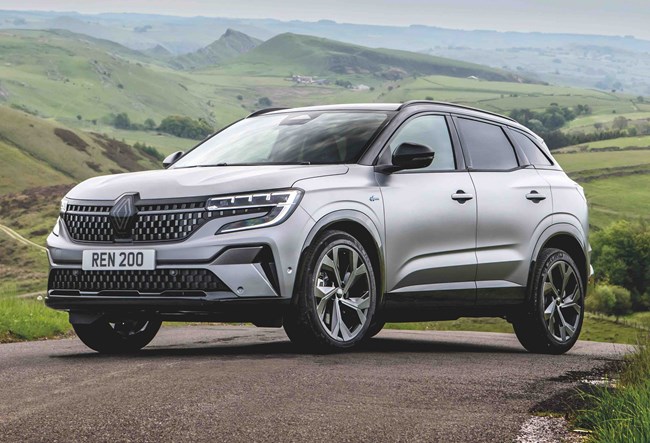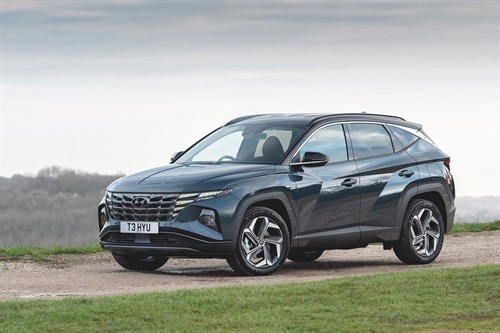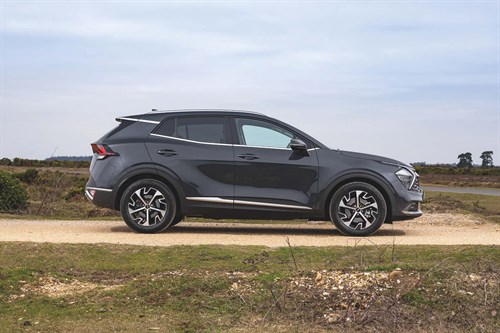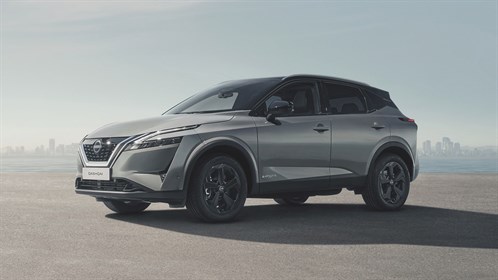We use cookies to ensure that we give you the best experience on our website. If you continue without changing your settings, we will assume that you are happy to receive all cookies on the Business Car website. However, if you would like to, you can change your cookies at any time

The start point for the best source of fleet information |
Best in Class: C-segment hybrid SUVs
Date: 12 September 2023 | Author: Martyn Collins

Renault Austral
The C-segment SUV marketplace is where Renault has had previous success with the Nissan Qashqai-based Kadjar - until it was discontinued last year. The Austral is its replacement, but it's much more than that, as it is its first model built on the third-generation CMF-CD platform, and in hybrid form, is unique to the Renault at the moment, with its aspiration to conquer the segment with this model.
Outside, although the Austral carries on styling cues first seen on the Megane EV last year, the design is more evolution than revolution. At the front, the heavily sculpted bonnet catches your eye first, followed by the large, mouthy grille with the new Renault badge in the centre and then there's the curvy, C-shaped matrix LED headlights.
The upswept window line at the side is unusual, plus the distinctive lower cut-out (which is shown off best with the Austral's matt paint finishes) and almost blistered arches which are home to wheels up to 20in in size. At the back, there's a high-set rear window, rear lights and light bar that stretch across the full width of the car and are a similar C-shape design to the headlights.
Inside, if you liked the Megane EV's style, you're going to feel right at home in the Austral. The dashboard is made up of screens, the biggest being a 12.3in upright OpenR one, which runs Google's Android Automotive software. It is certainly easy to use and supports Apple Carplay. This links with the smaller 12in screen for instruments. There's also a busy multi-function steering wheel, plus what looks like an elbow rest where the gearchange used to be on the centre console.
The Austral is available in Techno, Techno Esprit Alpine (which we're covering here), and Iconic Esprit Alpine equipment grades. All are powered by the same E-Tech hybrid drivetrain that Renault says is ideal for a C-segment SUV. It is made up of a 1.2-litre, three-cylinder turbocharged engine, with an electric motor and a 400v lithium-ion battery and a gearbox combining two speeds in electric mode and four for the combustion engine. Together, they equal 200hp and 409Nm of torque.
All the hybrid models in this article have similar BIK figures, but the Renault finishes first with its 26%, 2% below the second-place car - the Nissan. With the Kia next and the Hyundai in last place.
Hybrid models capable of almost 50 miles to a gallon, are at the top of their game in our opinion. So, the fact that the Renault boasts more than 60mpg is how the Austral finishes in first position for consumption. This is more than 6mpg better than the second-place car, again the Nissan, with both the Kia and Hyundai sisters having the same 49.6mpg figure.
French marques have tended to struggle against their Korean counterparts. Well that is the case with the Austral, when it comes to residuals. Renault can take some comfort that all the models had very close RV figures, but according to ours sourced from Kee Resources, its 40.63% figure is only good enough for third place, proving the fact that being the newest model here isn't enough to secure victory.
The Austral finishes in last place for depreciation, with its £21,649 figure, which is disappointing as it is the second most expensive car here with a P11D figure of £36,465. Although the Renault does have the lowest NI figure at £3,988.
Renault Austral 1.2 E-Tech 200 Techno Esprit Alpine
P11D: £36,465
CO2 (tax): 106g/km (26%)
BIK 20/40% a month: £158/£316
Fuel consumption: 60.1mpg
National Insurance: £3,988
First year VED: £175
Subsequent VED: £170
Engine size/power: 1,199cc/200hp
AFR: 13p
Residual value: 40.63%
Depreciation: £21,649
Fuel costs: £6,528
SMR: £2,563
Cost per mile: 51.23p

Hyundai Tucson
The Tucson is the also Korean sister car to our current Business Car of the Year, the Kia Sportage. Like the Kia, the Tucson has its own distinctive look, although it's less shocking now more than two years after launch.
Inside, the interior of this Hyundai is dominated by the 10.3in touchscreen for the infotainment. Whilst the instruments in front of the driver are taken care of by another 10.3 screen for the instruments. Leg and head room in the back of the Tucson is excellent and there's a practically shaped 620-litre boot.
Price dictates that we focus on the Premium equipment grade. This has all the standard kit you'd expect, with 18in alloy wheels, heated front seats and a Krell Premium sound system included.
The Tucson in this spec has the highest P11D figure here at £36,885, and also the highest CO2 emissions, while fuel costs are joint-highest. It does however reclaim some ground with the second-strongest expected residual values.
Hyundai Tucson 1.6h T-GDi Premium
P11D: £36,885
CO2 (tax): 130g/km (31%)
BIK 20/40% a month: £190/£381
Fuel consumption: 49.6mpg
National Insurance: £4,797
First year VED: £255
Subsequent VED: £170
Engine size/power: 1,591cc/230hp
AFR: 15p
Residual value: 44.79%
Depreciation: £20,365
Fuel costs: £7,910
SMR: £2,379
Cost per mile: 51.09p

Kia Sportage
Like its sister car, the Hyundai Tucson, the latest, fifth-generation Kia Sportage has its own bold look. However, there's more to our current Business Car of the Year than just its looks, as there's a choice of hybrid powertrains to suit company drivers that can't make the jump to EV. The interior is also spacious and attractive.
This self-charging hybrid has the 1.6 T-GDI petrol engine, which is combined with another electric motor and 1.49kWh battery, equalling 230hp. All this power is sent to the front wheels via six-speed automatic transmission, although four-wheel drive is available on the range-topping GT Line S.
All Kia Sportage versions are well-equipped, but the 3 grade adds 19in alloy wheels, LED front and rear lights, a panoramic sunroof and leather trim.
The Kia finishes in second place in terms of P11D (£36,015). It also has the second-lowest SMR figure at £2,344, the highest residual value at 45.51%, and is the lowest depreciator at £19,625, leading to its solid first position in this group of contenders.
Kia Sportage 1.6h T-GDi 3
P11D: £36,015
CO2 (tax): 129g/km (30%)
BIK 20/40% a month: £180/£360
Fuel consumption: 49.6mpg
National Insurance: £4,535
First year VED: £200
Subsequent VED: £170
Engine size/power: 1,591cc/230hp
AFR: 15p
Residual value: 45.51%
Depreciation: £19,623
Fuel costs: £7,910
SMR: £2,344
Cost per mile: 49.79p

Nissan Qashqai
The car that was instrumental in the crossover revolution, the Nissan Qashqai, remains one of the most popular on the market now. The current third-generation car was revealed just over a year ago, but the clever e-Power self-charging hybrid version was launched this summer. The e-Power's 190hp petrol engine does not drive the wheels directly, instead sending power to an electric motor.
Outside, from the front, the Qashqai looks sharp and modern with the slashed headlights that are high up in the body and the latest family grille. Inside, the driving position is excellent - with plenty of space even for the tallest. Access to the rear seats is also good, with rear doors that open to 85 degrees, and space is almost as good for two adults. Although the battery does reduce the boot space to a still-decent 504 litres.
The e-Power hybrid system works well enough, but its SMR (£1,963) and P11D figures (£35,935), are the only places where the Nissan leads. Although elsewhere there is not much to separate the Qashqai from the other cars in this set, with its 50.95 cost per mile figure putting it in second place behind the winning Kia.
Nissan Qashqai 1.5h e-Power N-Connecta
P11D: £35,935
CO2 (tax): 117g/km (28%)
BIK 20/40% a month: £167/£335
Fuel consumption: 54.3mpg
National Insurance: £4,228
First year VED: £200
Subsequent VED: £170
Engine size/power: 1,498cc/190hp
AFR: 15p
Residual value: 40.48%
Depreciation: £21,388
Fuel costs: £7,222
SMR: £1,963
Cost per mile: 50.95p











